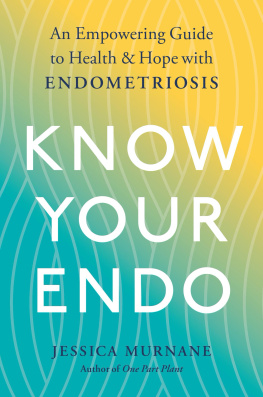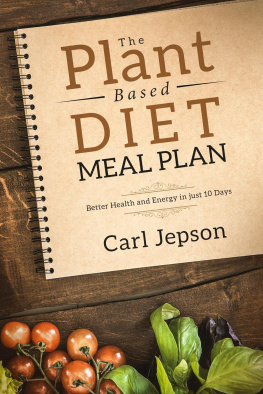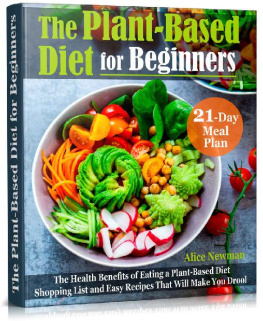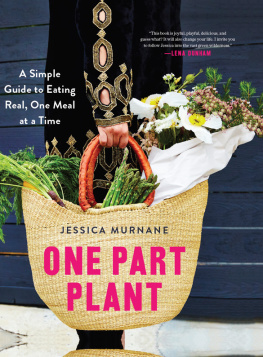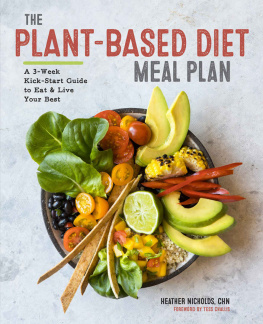Jessica Murnane
One Part Plant
Bluebird Books for Life
Contents

1 | Getting Down with OPP
What does One Part Plant (OPP) mean? OPP is an eating philosophy; it means at least one meal a day is made up of real, whole, plant-based foods. One. OPP is not some crazy diet with a list of forbidden foods you can never eat again, and it doesnt require you to join acuity food tribe with a million rules. OPP is about making plants the star of the show for one meal a day. Breakfast, lunch or dinner you pick. Once a day youll create, pick up or order in (no shame in that) a plant-based meal.
But lets back up for a second. If youre not familiar with the terms whole foods or plant-based, the concept is pretty simple. Whole foods are foods that are minimally processed or not processed at all veggies, fruits, nuts, seeds, grains and legumes. Plant-based means that these foods come from the ground and the trees and are not derived from animals (although many plant-based eaters consume honey, myself included).
I try really hard to avoid talking too much about the foods you CANT eat on a plant-based diet. For starters, Im not here to tell you what you can and cant eat as far as Im concerned, its your choice to eat whatever you want. But more importantly, rattling off a list of bad foods isnt a great way to get excited about a new way of eating; I know Id prefer to focus on all of the things I can eat rather than the foods that are off limits. That said, it wouldnt make a lot of sense if I didnt explain why certain foods for example, ones that start with ch and end with eese are not considered to be part of a plant-based diet and are not included in OPP.
That reason is inflammation.
Doctors, nutritionists and dieticians have been debating for years what the best diet is for overall health. And the results of that debate are, well, confusing. Theres so much information out there that its hard to find a single theory that everyone can agree on. But one idea remains pretty consistent in every camp: inflammatory foods are not our friends. Chronic inflammation has been linked to cancer, heart disease, diabetes, arthritis, depression and Alzheimers. We also know that women with endometriosis can experience more severe symptoms when they consume inflammatory foods. And even if you are fortunate enough to never experience one of these major illnesses, theres still a pretty good chance that inflammation will get in the way of you feeling your absolute best in some other way like persistent skin problems or digestive issues.
So what are inflammatory foods? The main culprits include processed and packaged foods, dairy products, red meat, sugar, fried foods, fizzy drinks, refined carbohydrates (pastries, white bread) and alcohol. You may have noticed some of your favourite foods in this list, and thats OK. Right now, Im simply identifying and sharing them with you. By becoming more aware of these foods, you can pay attention to how theyre making you feel when you eat them.
One other note about inflammatory foods: some people experience inflammation after eating grains, corn, soy, and nightshade vegetables (aubergine, peppers, tomatoes and potatoes). Each of us has a unique body, and we all react uniquely to different foods, even those that are widely considered to be healthy. Again, the important thing is not to swear off all of these foods completely, but to gain an awareness of how your body reacts when you eat them.
Wait a second, you may be thinking. You forgot about gluten. Isnt that THE biggest cause of inflammation?!
I know, I know. I was just getting to that.
When it comes to gluten, everyone has an opinion. Some experts say its the worst thing you could possibly put in your body, and others that say its perfectly safe. New studies with contradictory findings seem to make headlines every day, and its hard to keep up with all of the evolving research on gluten, let alone know if its safe to eat a piece of bread.
Personally, I dont include much gluten in my diet. For my body, it can cause pretty serious inflammation, which isnt great for endometriosis. I eat it on occasion, maybe once a month. But just because Im (almost) gluten-free doesnt mean that you need to swear off gluten. So in an effort to offer you the best information I can find on this topic, I asked a doctor I trust Thomas Campbell, MD (author of The China Study Solution) to share his thoughts. Heres a summary of our conversation:
JM: Can someone be sensitive to gluten i.e., have some adverse reactions to it and not necessarily be allergic to it?
TC: There are three types of reactions with gluten: allergies, autoimmune (coeliac) and non-coeliac gluten sensitivity. Some people do have problems with gluten without having allergies or coeliac disease. Its important to note that many of these people are likely to be sensitive to other foods as well, notably dairy.
JM: How do you know if you are sensitive to gluten but dont have coeliac disease or an allergy?
TC: There are no good, reliable tests to make a definitive diagnosis of non-coeliac gluten sensitivity. The best test is to find a programme where you can get exposure to gluten without knowing it while tracking your symptoms. In studies, researchers give patients muffins or other baked items. Some contain gluten, and some do not. Then they track their patients symptoms and see if the gluten exposure actually provokes symptoms. Interestingly, a majority of patients who feel they have non-coeliac gluten sensitivity actually show no correlation between symptoms and gluten exposure when they are tested in this way. In the absence of this type of testing, which removes the placebo effect, people can simply try a gluten-free diet and see how they feel. I do suggest people talk to their doctor first to get tested for coeliac. You cannot test for coeliac in a reliable way if you are already on a gluten-free diet. So see your doctor before making the switch.
JM: Why does gluten get such a bum rap?
TC: Gluten has been the target of several popular diet books that suggest people should eat a low-carbohydrate diet. There is a slight kernel of truth to these books at the start, but they go on to reach conclusions with which I strongly disagree. One of the most over-consumed foods, usually in the form of highly processed items, is refined flour. Biscuits, cakes, pastries, white bread, white pasta, pizza these are all junk foods that contain lots of unhealthy ingredients above and beyond refined flour. If you get rid of them, youll be healthier. But its a remarkable stretch to say that nearly all of our health problems are specifically due to gluten, as these popular books tend to do.
So: the choice is yours. Because I know that my tummy is pretty sensitive to gluten, I eat gluten in moderation and usually stick to gluten-free grains, gluten-free flours and sprouted breads (Ive found these dont cause me as much trouble). The recipes youll see in this book are intended to be made with breads and grains that are gluten-free, sprouted or fermented. But that doesnt mean that you have to follow every recipe the way I would. If you want to sub in some whole wheat bread in place of gluten-free bread, go for it. Or if youd rather have some barley or farro in your curry bowl instead of brown rice, I wont judge.
If you do decide to go 100 per cent gluten-free, a word of warning: beware of all of the gluten-free packaged products out there and read labels very carefully. A lot of brands remove the gluten from a food but then replace it with a whole slew of ingredients that might make you feel even worse (examples of these are processed starches, soy and various sugars). In general, if youre eliminating gluten from your diet, I recommend eating foods that are naturally gluten-free instead of foods that are altered to be that way.


